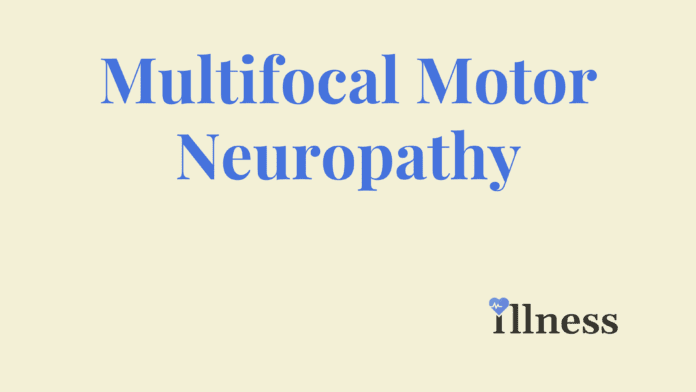Overview
Multifocal Motor Neuropathy is a rare disorder characterized by slowly progressive muscle weakness, primarily of the arms and legs. The disorder is considered to be immune-mediated, which means there is inflammation resulting from abnormal functioning of the immune system and the presence of specific autoantibodies that target a specific protein in the body. Other symptoms including muscles cramps and wasting (atrophy) of muscles can also occur. The term multifocal means arising from two or more spots. The term motor refers to the motor nerves, which are those that carry nerve impulses from the brain to the muscles. The exact, underlying cause of this disorder is not fully understood. The disorder is acquired at some point during a person’s life; a person is not born with the disorder. Multifocal motor neuropathy usually responds to treatment with intravenous immunoglobulin.
Cause
MMN is associated with increased levels of specific antibodies to GM1, a ganglioside or sugar-containing lipid found in peripheral nerve. Antibodies normally protect individuals from viruses and bacteria, but may under certain circumstances bind to and facilitate an immune attack on the peripheral nerve. These antibodies have been detected with newer assays in almost all of MMN patients. Even if these antibodies do not cause the nerve damage, they may be an important marker for disease and facilitate diagnosis.
Symptoms
Multifocal motor neuropathy is a progressive disorder, this means that the signs and symptoms tend to worsen slowly over time. The main symptom is progressive muscle weakness of the arms and legs. Unlike other neurological disorders affecting the arms and legs, there usually is not any sensory deficits. This means that feelings of tingling or numbness or pain are not associated with the disorder. Muscle weakness often begins in the hands, causing hand weakness and affected individuals may drop objects frequently or have difficulty performing tasks that require fine motor skills such as turning a key in a lock. Fine motor skills are those that require small movements involving the hands and wrists. Some individuals have trouble extending or bending their wrist upward (wrist drop). Reduced grip strength of the hands and reduced dexterity of the hands is seen. Sometimes, muscle weakness starts in the legs. There may be reduced mobility of the toes and foot drop may be early signs. Foot drop occurs when weakness of the muscles involving in lifting the food cause the foot to drop or drag when attempting to walk.
As muscle weakness progresses, severe fatigue in the affected muscles may be seen and the disorder will cause functional disability. Affected individuals may have limited endurance. The muscles on one side of the body that are affected may be different from the muscle affected on the other side of the body (asymmetrical muscle weakness).
Additional symptoms associated with multifocal motor neuropathy include cramping, involuntary muscle contractions or “twitches” (fasciculations), decreased muscle tone, and, sometimes absent deep tendon reflexes. Later in the progression of the disease, wasting (atrophy) of the affected muscles may occur.
Other muscles such as those affecting breathing are unaffected and the disorder usually does not affect life expectancy.
Treatment
It is now established that intravenous immunoglobin (IVIg), a preparation of antibodies obtained from healthy volunteers, can be readily given through an arm vein and provides benefit to patients with MMN. It is the only treatment for this disorder that is approved by the Federal Drug Administration (FDA) and regulatory agencies in Europe and Canada. IVIg can lead to improved motor function in most patients with MMN, with the response varying from minimal to very large. Early treatment shortly after symptom onset is always more effective. The treatment usually does not completely reverse all of the symptoms, and those patients who do respond will require repeated treatments to maintain their improvement. Patients usually require retreatment every 2-5 weeks and over time may need increased doses of IVIg.
IVIg is not a cure for MMN but currently no other therapy has proven to be widely effective. In a limited number of patients a cancer chemotherapy drug, cyclophosphamide, is temporarily effective. However, its use is limited by the toxic side-effects and risks that accrue with chronic use. Other immunosuppressive treatments such as corticosteroids and plasma exchange are ineffective and can actually make the disease worse.
Many investigators around the world are working towards a better understanding of MMN.
Other
The diagnosis of MMN is a clinical one that depends on demonstrating that the patient:
• has a purely motor disorder affecting individual nerves
• there are no UMN (upper motor neuron) signs such as brisk reflexes at the knees or ankles or spasticity in the limbs
• there is no difficulty speaking or swallowing
• there are no sensory deficits
• there is evidence of focal areas of nerve in which electrical impulses are slowed or blocked (conduction block) which can be detected on electrophysiology tests
These criteria are designed to differentiate MMN from ALS, (Lou Gehrig’s disease), Lewis-Sumner Syndrome (a multifocal inflammatory nerve disease with motor and sensory symptoms), and vasculitis or inflammation of small blood vessels in the peripheral nerve.
A neurologist is usually needed to determine the diagnosis, which is based on the history and physical examination. Tests include:
• an electrodiagnostic study, which includes nerve conduction studies (NCS) and needle electromyography (EMG).
• Laboratory testing for IgM GM1 antibodies is also frequently done.
Source
Courtesy of MedlinePlus from the National Library of Medicine



